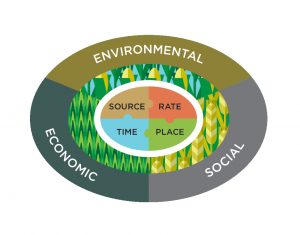About the 4Rs
The 4R approach is about optimizing resources and finding the “right” strategies for your farm.

4R Nutrient Stewardship is a management concept that seeks to match nutrient applications, such as fertilizer and manure, as closely to crop needs as possible. The 4Rs refer to the the right nutrient source, at the right rate, at the right time, in the right place. Applying 4R Nutrient Stewardship concepts can help to improve nutrient use efficiency on farms, making farms more profitable and reducing losses to the environment.
4R management principles are specific to each farm, field and growing season. The right combination of practices for each farm will consider economic, environmental and social factors, and may include practices such as variable-rate nutrient applications and other precision agriculture technologies, nitrogen modeling, and split application of nutrients.
4R Principles

When we talk about the right nutrient source, two key principles include ensuring a balanced supply of nutrients that suit soil properties. Nutrient sources can include commercial fertilizer, manure from livestock operations, compost, crop residues, and organic material from municipal wastewater treatment systems. Other principles include:
- Supply nutrients in plant-available forms.
- Recognize synergisms & antagonism among nutrient elements and sources.
- Recognize blend compatability.
- Recognize benefits and sensitivities to associated elements.
- Control effects of non-nutritive elements.

Principles that guide the right rate include assessing the nutrient supply from all sources and assessing plant demand. Examples of practices that support the right rate include testing soils for nutrients, calculating the economics, and balancing nutrients lost in crop removal. Other principles include:
- Select a reasonable yield target.
- Assess soil nutrient supply and account for all available nutrient sources.
- Predict use efficiency of nutrient sources.
- Consider soil resource impacts.
- Consider rate-specific economics.

The right timing assesses the dynamics of crop uptake and soil supply, to match nutrient availability as closely as possible to crop need. Decisions that support the right timing evaluate the risk of nutrient loss. Practices include pre-plant and at-planting nutrient applications and one or more sidedress applications. Timing is one of the most critical factors for Delmarva farmers to reduce nutrient losses. Other principles relating to right timing include:
- Recognize dynamics of crop management practices and soil nutrient loss.
- Evaluate logistics of field operations.
The right place seeks to manage spatial variability and recognize crop rooting patterns. Options include broadcasting, banding, drilling, and injecting, as well as precision agriculture practices that incorporate variable-rate applications. Additional principles supporting the right placement of nutrients include:
 Consider soil chemical reactions.
Consider soil chemical reactions.- Suit the goals of the tillage system.
- Manage spatial variability.
(The information above is adapted from 4R Plant Nutrition.)
4R Plus looks at the whole system.
All of these principles are interrelated and must be considered together. 4R Plus is a whole system approach, incorporating practices that help to improve habitat, soil health and drainage management. 4R Plus systems may include:
- Adding biodiversity and continuing living roots to a system through crop rotations or cover crops, to feed soil microorganisms, cycle nutrients and improve water quality
- Reducing disturbance through low-till or no-till systems
- Support wildlife habitat through wetland restoration, buffers and other practices
- Integrated Pest Management (IPM) strategies, using cultural practices to reduce pest pressure, support beneficial insects and reduce the use and impact of pesticides
- Addressing nutrient losses at the edge-of-field by filtering drainage water that leaves a field through drainage tile or ditches, such as riparian and grass buffers, saturated buffers, gypsum curtains, denitrification (wood chip) buffers, and others
These and other farm management practices affect and are affected by the right source, rate, timing and placement of nutrients. Taking a 4R Plus approach helps to ensure a thriving agricultural legacy for future generations!
What are the Benefits?
4R Nutrient Stewardship looks at decision management in the context of the economic, environmental, and social impacts of a practice. Another way to look at these factors is Profit, Planet & People.The “right” management system for a given farm should benefit each of these factors by reducing input costs and/or improving yields, reducing nutrient losses and without compromising quality-of-life for farmers, employees or communities.
A good place to start is to identify the objectives for implementing a 4R management system. The “right rate” will differ between objectives to maximize yields or increase profit, for example. Having clearly defined performance objectives will help to guide decisions on which new management practices have the potential to fit your operation, the criteria that should be used to evaluate performance, and whether or not the new practice is meeting the desired objective.
Benefits of implementing 4R management can include:
- Reducing inputs and input costs
- Better crop quality
- Improved yields
- Reduced erosion and nutrient leaching
- Financial incentives through nutrient trading or other sustainability markets
4R practices and their benefits will vary according to each farm, field and growing season, but should line up with the identified objectives. Each growing season is an opportunity to evaluate the outcome from the previous season and make adjustments that will offer continuous improvement toward the goals of the farm.
A few examples of the benefits of specific practices include:
- Nitrogen Modeling supports decisions that apply the right rate at the right time by estimating the amount of nitrogen available to a growing crop throughout the season, based on site-specific environmental and management information. A study evaluating the use of Nitrogen Modeling to guide fertilizer side-dress rates to corn showed that rates were on average 47 lb/ac lower for growers in New York, with no statistically significant difference in yields. On average, use of Cornell’s model, Adapt-N, increased grower profits by $26 per acre and reduced simulated environmental N losses by 25 lb/ac (38%).
- Cover Crops can help to retain and cycle nutrients in the soil by scavenging nitrogen left over at the end of a growing season, preventing erosion and building soil organic matter. Cover crop management, including selection of species and mixes and establishment/termination timing, can be tailored to support the goals of each farm and field. Early-planted rye can take up more than 70 lb of nitrogen per acre, and as much as 140 lb/acre of nitrogen has been measured 7-10 after termination of a pure hairy vetch stand. (SARE’s book, Managing Cover Crops Profitably, is available online.)
- Variable Rate Nutrient Applications support right placement and right rate for fertilizer applications, by quantifying the spatial variability in soil conditions and managing inputs to address that variability. Different management zones can be based on variability in historic crop yields, soil types, grid or zone soil sampling results, optical sensors, or other criteria. The return on investment for variable-rate technologies seems to be dependent on the amount of spatial variability. Ensuring that management strategies are addressing the right reason for variability is also critical. In one study, use of crop sensors saved an average of 23 lb N/acre relative to the rate the producer would normally use with no effect on average yield. Researchers attributed the savings to better timing of the in-season fertilizer application, as well as better assessment of the right rate.
